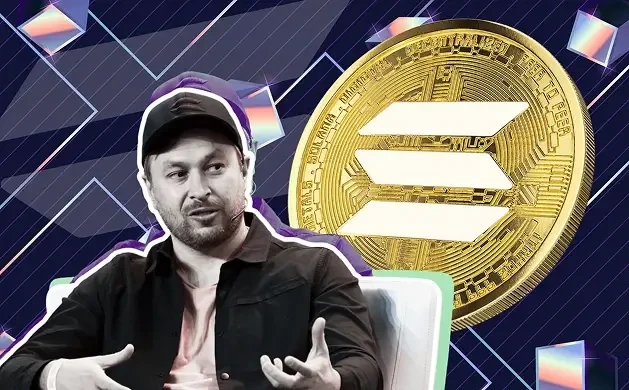Dialogue with Solana founder Anatoly: The market is over-pursuing stablecoins but underestimating their true potential
Host: Sam, Rosa
Guest: Anatoly Yakovenko, Founder of Solana
स्रोत: Crypto Isnt for Everyone (And Thats a Good Thing) with Anatoly Yakovenko
Podcast date: July 12, 2025
Compiled and edited by Lenaxin and ChainCatcher
सारांश:
This article is compiled from an in-depth conversation with Solana founder Anatoly Yakovenko on the More or Less podcast. He analyzed the industry cycle of punk, hoodies, and suits, pointed out that AI is just a product and क्रिप्टो is a movement, and revealed how stablecoins quietly promote the globalization of the US dollar. At the same time, he explained the mission of Solana Mobile to challenge the monopoly of app stores and proposed that the future of the crypto industry does not lie in popularization, but should focus on serving high-net-worth niche groups.

Wonderful points:
-
AI is a product, but encryption is a movement
-
If Bitcoin becomes a hedge tool on par with gold, the crypto market will be a winner
-
Developing exclusive devices and app stores for crypto users and charging low fees can open up new paths in the monopoly of giants
-
When stablecoins are backed by real assets such as government bonds, they will subvert the traditional financial system.
-
The current market perception of stablecoins is both over-focused and seriously underestimated
-
Real market demand is still highly concentrated in US dollar stablecoins
-
When individuals are immersed in such information cocoons for a long time, it is inevitable that cognition will be out of touch with reality.
-
When those who hold on to their ideals withdraw, their voices disappear
Opening Story: The Growth of Anatoly and the Birth of Solana
Rosa: Could you please briefly introduce the background and the creation process of Solana?
Anatoly: I was born in the Soviet Union. My parents immigrated right after the fall of the Berlin Wall, or more precisely, the Soviet Union. I grew up in Chicago and came to the United States when I was 11, right at the height of Michael Jordans Chicago Bulls career, and was completely immersed in that craze. I spent the 90s there, and then went to Illinois State University to study computer science.
It was the time of the mobile phone revolution. I worked at Qualcomm from 2004 to 2015, participated in all the mobile phone research and development projects you can think of, and came into contact with all the mobile operating systems at the time.
As for the opportunity to create Solana, it was at Soleil Cafe in San Francisco one day, after drinking two cups of coffee and a bottle of beer, and suddenly a flash of inspiration came to me when I was tossing and turning at 4 a.m. Six months later, I pitched the idea to Sam Russo at Slow Bar.
The Evolution of Crypto: Punks, Hoodies, and Suits
Rosa: This is a critical period: regulations have been significantly relaxed and innovative projects have emerged intensively. In your opinion, what is the current market situation like? What are the essential differences compared to a year ago?
Anatoly: I have observed that the crypto movement has many similarities with other technology waves, such as the open source movement. Objectively speaking, AI is closer to a specific product than a social movement. This development model always follows a fixed trajectory: initially pioneered by punk rebellious geeks, then commercialized by hoodie entrepreneurs, and finally fully taken over by suit capital.
We are currently in a delicate transition period, with entrepreneurial hoodie teams becoming increasingly mature, and suit capital just beginning to explore how to incorporate this industry and try to transform it into a form that is no different from traditional industries.
Rosa: Speaking of capital inflow, hedge funds and traditional asset management companies are now issuing various crypto products. Do you mean they will directly incorporate the underlying blockchain technology?
Anatoly: Stablecoins are a ready-made success story. This kind of programmable currency is simply perfect, especially when it is backed by real assets such as government bonds, which is equivalent to directly subverting the traditional financial system built on fax machine technology since World War II.
Rosa: What is the actual value of stablecoins to the U.S.?
Anatoly: When the world is thirsty for dollars, if Tether or Circle becomes the standard carrier of programmable dollars, the United States can only follow the trend. After all, the current global economic scale has made the transformation of the dollar system inevitable. Ordinary consumers will certainly not give up credit cards, but Visas cooperation model with banks will definitely be innovated because it can directly reconstruct the entire clearing system based on stablecoins.
Observation on the Evolution of Crypto Ecosystem: From Value Storage to Meme Economy
Sam: Will traditional financial institutions’ acceptance of crypto technology take the form of an open transformation or a covert penetration model?
Anatoly: The key lies in functional realization. If banks only allow holding Bitcoin but do not support actual use, the situation will become delicate. When this model is scaled up, Bitcoin may evolve into digital gold. Although from the perspective of Securities Analysis, neither Bitcoin nor gold can be valued using the discounted cash flow model.
The fundamental motivation for people to hold them is fear, just as my parents did when they fled the Soviet Union with their gold. It is perhaps the only reasonable explanation that Bitcoin plays the same role today. If Bitcoin becomes a mainstream hedging tool on par with gold one day, then the entire crypto market will be successful no matter how you define success.
Sam: When traditional valuation models generally fail, what is the essential difference between crypto assets and stocks/gold? Isnt gold a millennial meme?
Anatoly: The difference is in scale. When the gold meme reaches trillion-dollar levels and forms a global consensus, it reflects something about the nature of human civilization, that we have always used abstract concepts to store and transfer value.
Sam: Can you compare the different value systems in the crypto space?
Anatoly: Bitcoin’s abstractness makes it difficult to value using engineering thinking, but Solana’s positioning is very clear: it is essentially an efficient information transmission channel. When users trade tokens, they are actually broadcasting valuable information. Since the system only executes the first matched transactions, an incentive mechanism for paying priority fees is naturally formed. The larger the transaction volume processed by the channel, the higher the income generated. It doesn’t matter whether Bitcoin or USDC is transmitted, the system only processes the data flow.
We are lucky to live in an increasingly wealthy world, and when people have more disposable money, they naturally invest in all kinds of interesting things. For example, meme coins, some people think it is fun to issue a Bowdoin coin that spoofs Biden.
Rosa: Are all meme coins based on Solana?
Anatoly: At present, the vast majority are. Although there are several top market caps on Ethereum, Solana can generate 20,000 to 50,000 new meme coins every day, and even more than 100,000 during peak periods.
Sam: Why is the infrastructure construction of the meme coin ecosystem seriously lagging behind?
Anatoly: This is actually a system engineering problem. As long as it involves value distribution, there will be people who take advantage of loopholes. Just like when selling mobile phones at a discount, countless virtual accounts will pop up to take advantage of the situation.
Encrypted mobile phone strategy: Decoding the platform competition
Rosa: Why did Solana choose to enter the mobile hardware field?
Anatoly: This stems from my professional background: I have been deeply involved in the mobile phone industry for more than ten years, and I was able to build a core team. The current Internet should be open and free, but it is being confined to users and monetized by the sandbox model of companies such as Apple. Although it creates value, this closed ecosystem is suffocating.
Apple, Google, and Meta are all using sandbox mechanisms to extract user value. Although their products are indeed excellent (for example, I am using Googles free email AI), encryption technology can break this monopoly. Because digital assets such as एनएफटी and meme coins are scarce, it is difficult for platforms to charge a 30% commission like they do for game props. After all, these are not virtual goods that can be infinitely replicated.
The scarcity of crypto assets has completely changed the rules. Take the cryptopunk NFT as an example: there is only one in the world, and it cannot be infinitely copied like a game prop. When a user spends $10,000 to buy it, the Apple Store cannot charge a 20% handling fee. Users will not accept it, and the issuer will find it difficult to afford it.
This fundamental conflict reveals an opportunity: developing dedicated devices and app stores for crypto users and charging fees far lower than traditional platforms (for example, 0.5% instead of 30%) can open up new paths in the monopoly of giants.
Rosa: The business model is to earn transaction fees?
Anatoly: Just like Binance or Metamask, a tiny fee is charged for massive crypto transactions. Although the fee rate is less than 1/30 of that of traditional platforms, the average transaction amount per crypto user is dozens of times that of ordinary Internet users.
Rosa: To attract talent to build crypto infrastructure, do we need to adjust the existing incentive system?
Anatoly: The key lies in the target user positioning. I am not sure whether the general public needs encryption products. However, although the existing encryption user group only accounts for 1% of the global population (about 100 million people), their average user revenue (ARPU) is dozens of times that of ordinary Internet users.
Just as Pump.fun’s founders were determined to challenge TikTok after their initial success, entrepreneurs are always chasing the ultimate goal in their hearts.
How Stablecoins Affect the Global Monetary Landscape
Rosa: How will the listing of stablecoins such as Circle affect the crypto financial ecosystem?
Anatoly: There is an obvious contradiction in the current markets perception of stablecoins: it is over-focused and seriously underestimates its potential. Imagine that the global stablecoin circulation reaches 5 trillion US dollars, which means that the US dollar has completed a comprehensive digital transformation and has become a daily currency in Europe, Southeast Asia and even Africa.
In an environment lacking official support from the U.S. government and facing strict regulatory pressure, the stablecoin market size has exceeded US$250 billion, and this development trend will continue to accelerate.
Rosa: Has there been a change in the current policy stance of global regulators towards stablecoins?
Anatoly: There has indeed been a shift in regulatory attitudes this year, but the legislative process will still take 2-4 years to complete. Bitcoin has formed a unique value belief system, and the development trajectory of other encrypted applications is just like the early popularization of email technology, and its final form cannot be accurately predicted.
Sam: How will stablecoins affect the global monetary landscape?
Anatoly: The data clearly reveals the current situation: the development of the euro stablecoin is hindered, and the RMB stablecoin mainly relies on policy drivers.
However, the real market demand is still highly concentrated in the US dollar stablecoin. Even street vendors in Argentina have generally adopted USDT to hedge the inflation risk of their own currency. This process of dollarization driven by the private sector may further consolidate the global dominance of the US dollar.
Rosa: Does this mean that “native stablecoins” are just VC wishful thinking?
Anatoly: Under the current financial infrastructure framework, the US dollar stablecoin has effectively solved the actual payment pain points. Just as cross-border e-commerce generally adopts the existing model of US dollar settlement, the on-chain economy is spontaneously forming a similar US dollar-dominated settlement area. Unless there is mandatory policy intervention, this currency pattern based on network effects will remain stable.
Sam: Is the global penetration of US dollar stablecoins reshaping the new paradigm of US dollar hegemony?
Anatoly: From the actual effect point of view, spontaneous choices at the micro level are more influential. When Argentine traders voluntarily adopted USDT for trade settlement, this spontaneous dollarization process was more effective than any policy intervention. If the stablecoin market size exceeds 1 trillion US dollars in two years, it means that 5% of the global US dollar supply has completed the transformation to on-chain form.
The public opinion dilemma in the crypto world
Rosa: Linda has a strong network of media, clients, and industry contacts. I think she still has a bright future. This comes on the heels of the Grok controversy, where Grok made anti-Semitic comments that Musk downplayed. What do you think of this controversy?
Anatoly: This is the norm on the Internet. There are always people spreading malicious intent. Interestingly, people try to solve this problem with cryptocurrency, such as developing anti-counterfeiting coins. But once AI systems are open to public input, it is bound to be someone who deliberately crosses the line. To be honest, Groks remarks are quite restrained.
Rosa: In the information trust crisis, can encryption technology reconstruct the trusted verification mechanism?
Anatoly: It is more likely to return to the prediction market (Polymarket). Although there is room for manipulation, checks and balances will be formed under the scale effect.
Rosa: What do you think of Sequoia Capital partner Shawn Maguire being recently labeled an “Islamist” for his comments on the Mandani project?
Anatoly: Although I dont always agree with Shawns views, and sometimes he even seems aggressive, I support the principle of freedom of speech. The Internet should accommodate different voices, and people can disagree with his views, but they should not deprive him of the right to speak.
Rosa: Why did Shawn Maguire choose controversial statements rather than professional means to gain attention?
Anatoly: This phenomenon is essentially the same as the dilemma of Internet information quality: highly cognitive people tend to pursue maximum information absorption and form judgments on everything, while algorithms will continue to push content that reinforces existing biases in order to maintain user stickiness.
For example, if the user determines that Currys shooting is inefficient, the system will loop the clips of his missed shots. When individuals immerse themselves in such information cocoons for a long time, it is inevitable that cognition will be out of touch with reality.
Rosa: What is the attitude of the cypherpunks towards the current industry ecosystem? Are they furious, or are they too busy making money to care about other things?
Anatoly: That’s an interesting question. The really angry punks have left. Just like no one remembers the open internet before Facebook, when the people who held on to their ideals left, their voices disappeared with them.
अस्वीकरण
The content of this article does not represent the views of ChainCatcher. The views, data and conclusions in this article represent the personal positions of the original author or the interviewee. The compiler maintains a neutral attitude and does not endorse its accuracy. It does not constitute any advice or guidance in any professional field. Readers should use it prudently based on independent judgment. This compilation is limited to the purpose of knowledge sharing. Readers are requested to strictly abide by the laws and regulations of their region and not participate in any illegal financial activities.
This article is sourced from the internet: Dialogue with Solana founder Anatoly: The market is over-pursuing stablecoins but underestimating their true potential
Original | Odaily Planet Daily ( @OdailyChina ) Author | Ethan ( @ethanzhang_वेब3 ) On June 30, Eastern Time , Circle (CRCL), the issuer of the stablecoin USDC and the “first stablecoin stock”, announced that it had officially submitted an application to the U.S. Office of the Comptroller of the Currency (OCC) to establish a federal trust bank called “First National Digital Currency Bank (NA)”. According to the announcement on Circle’s official website, once approved, the bank will become Circle’s first federally regulated custodial entity. It will not only be able to independently manage its more than $60 billion in USDC reserve assets, but will also provide digital asset (especially tokenized bonds and stocks) custody services to institutional clients. Unlike traditional banks, this license does not allow for the acceptance…







